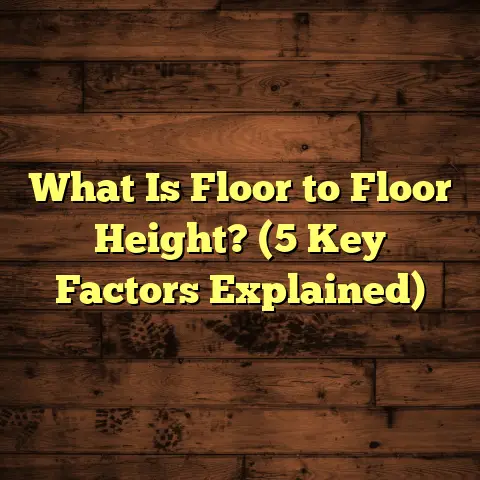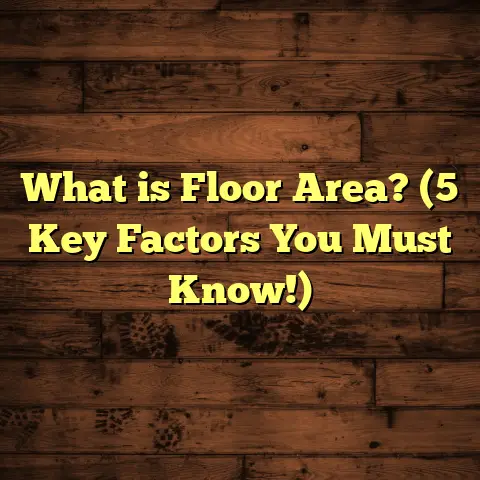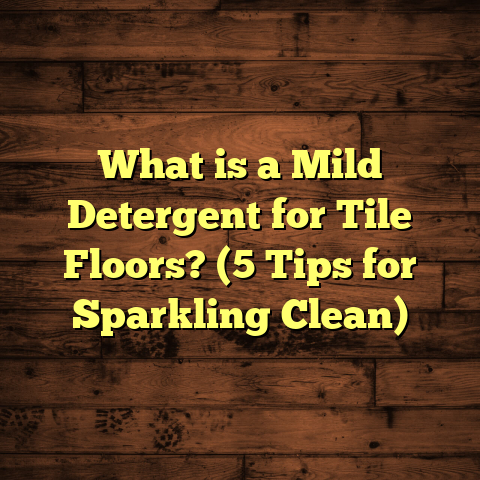What is Floor Trends? (5 Key Styles Shaping Interior Design)
When I think about flooring trends, my mind drifts back to ancient Rome. The Romans were masterful at creating floors that were both functional and beautiful. Their mosaic floors, made from tiny colored stones, weren’t just surfaces to walk on—they told stories, celebrated heroes, and reflected the culture of the time. Walking through the remains of those palaces and villas today, you can still feel that connection to history in every step. Floors have always been more than just something beneath our feet; they are a canvas for expression, a foundation for comfort, and a marker of technological progress.
Fast forward to today—flooring continues to evolve in fascinating ways. New materials, innovative installation methods, and shifting tastes all influence the styles that dominate the market. As someone who has installed and restored floors for years, I’ve witnessed firsthand how trends emerge, fade, and sometimes come back stronger than ever.
What Is Floor Trends?
You might ask: what exactly are floor trends? Simply put, floor trends are the popular styles, materials, colors, textures, and installation techniques that shape how flooring looks and functions in homes and commercial spaces over a certain period. They reflect broader design movements but also respond to practical needs like durability, budget, and environmental concerns.
Floor trends are like fashion for your floors—they tell you what’s “in” right now but also give clues about what might last. For example, shag carpets dominated the 1970s but are rarely seen today except as nostalgic throwbacks. In contrast, sustainable materials have gone from niche to mainstream in just a few years.
Understanding these trends helps homeowners make choices that balance beauty with longevity. For contractors like me, staying abreast of trends means offering clients options that fit their vision and lifestyle while avoiding quick fads that might look dated soon.
Why Should You Care About Flooring Trends?
When I chat with clients about new flooring, one question comes up often: “Will this style still look good in 10 years?” It’s a fair concern. Floors are a big investment—not just in money but in time and effort to install. You want something that feels fresh today but doesn’t scream “old-fashioned” tomorrow.
Another common question is about cost: “How do I get the look I want without breaking the bank?” Trends can influence pricing—new materials sometimes cost more initially but may save money over time through durability or low maintenance.
In my experience, knowing about trends also helps clients visualize how different floors will interact with their furniture, lighting, and overall home vibe. I always encourage people to think beyond just today’s taste to how they want their space to feel years down the line.
One tool that’s helped me immensely with budgeting is FloorTally. It’s a calculator designed specifically for flooring projects—factoring in local labor rates, material costs, waste percentages based on cuts or patterns, and even different installation types. This tool means I spend less time hunting prices and more time focusing on showing clients samples and explaining options.
The 5 Key Styles Shaping Interior Design Today
Let’s get into the heart of it—the five key flooring styles currently shaping interior design. These trends aren’t random; they reflect shifts in technology, lifestyle, environmental awareness, and aesthetics.
1. Natural Wood Looks — Timeless Meets Trendy
Wood flooring has been a favorite for centuries because of its warmth and character. Right now, the trend is moving toward natural wood looks with less sheen and more visible grain. Think wide planks with knots and texture rather than perfectly smooth shiny surfaces.
When I installed a wide-plank white oak floor for a client last year, they wanted something that felt organic and lived-in—not showroom perfect. The matte finish showed off the wood’s natural imperfections beautifully. This style not only adds warmth but connects the interior with nature.
Why Natural Wood?
- Sustainability: Many mills now source wood responsibly.
- Durability: Engineered hardwood options offer better moisture resistance.
- Refinishing: Wood floors can be sanded and finished multiple times.
According to data from the National Wood Flooring Association (NWFA), sales of engineered hardwood with natural finishes grew by 18% in 2023 alone. This shows homeowners crave authenticity over artificial shine.
Installation Insights
Natural wood floors require skilled installation to avoid gaps or unevenness. I usually recommend acclimating the wood planks onsite for several days before installation to prevent expansion issues later.
Maintenance Tips
Matte finishes hide scratches better than glossy ones but still need regular cleaning with products designed for hardwood. Avoid excessive water which can damage wood fibers.
2. Large Format Tiles — Clean Lines and Big Impact
Tiles have come a long way from tiny squares. The current trend favors large format tiles—sizes like 24×48 inches or even bigger slabs—that cover large areas with fewer grout lines. This creates a sleek surface that visually expands rooms and simplifies cleaning.
I installed large porcelain tiles in a client’s kitchen recently. The floor looked almost seamless and made the space feel modern yet welcoming.
Why Large Format Tiles?
- Visual spaciousness: Fewer grout lines create an impression of openness.
- Low maintenance: Less grout means less dirt buildup.
- Style versatility: Many tiles mimic wood grain or stone textures now.
A Freedonia Group study reported large format tile sales rose by 22% globally in 2023—a big jump that matches consumer preference for minimalist design.
Installation Details
Large tiles require flat subfloors because unevenness shows quickly on big surfaces. Cutting large tiles cleanly demands professional-grade tools.
Care Advice
Porcelain is naturally stain-resistant but grout should be sealed periodically to prevent discoloration.
3. Eco-Friendly Flooring — Style Meets Sustainability
More homeowners want floors that tread lightly on the planet. Bamboo, cork, reclaimed wood, and recycled vinyl are no longer niche products—they’re mainstream choices.
I had a client who chose cork flooring for their home office because it was soft underfoot and reduced noise—a perfect combo for work-from-home life.
Why Choose Eco-Friendly?
- Renewable resources like bamboo grow quickly.
- Reclaimed wood adds character by recycling old materials.
- Low VOC finishes improve indoor air quality.
- Sound absorption benefits like cork reduce echo.
The global green flooring market is expected to grow annually by roughly 7% through 2027 (Grand View Research).
Installation Notes
Cork needs moisture barriers if installed below grade. Bamboo requires acclimation like hardwood.
Maintenance Tips
Eco-friendly floors usually need gentle cleaners and occasional refinishing depending on material type.
4. Bold Patterns and Geometric Designs — Floors as Statement Pieces
Gone are the days when floors were just backgrounds for furniture. Patterns like herringbone, chevron, or hexagonal tiles are gaining popularity as floors become focal points.
One project I remember well was a downtown loft with herringbone hardwood throughout the living room. The pattern added rhythm and energy to the open plan space.
Why Patterns?
- Add visual interest without clutter.
- Can blend traditional charm with modern flair.
- Define spaces in open concept homes.
Houzz data shows patterned floors jumped 15% in popularity among remodelers in 2023.
Installation Challenges
Patterns require precise cuts and alignment—mistakes show easily. This often means higher labor costs.
Cleaning Tips
Patterned tiles can hide dirt better than plain ones but grout lines still need regular attention.
5. Mixed Materials — Blending Textures for Visual Interest
Mixing different flooring types within one area is becoming trendy. For example, hardwood flows into tile near kitchens or carpet borders hardwood in living spaces to define zones without walls.
I helped a client design an open-concept home where we transitioned from durable porcelain tile in high-traffic kitchen areas to warm walnut hardwood in adjacent dining spaces using discreet metal strips to protect edges.
Why Mix Materials?
- Offers functional benefits (e.g., tile near water sources).
- Creates visual separation.
- Adds texture variety for tactile interest.
Remodeling Magazine reports homes with mixed-material floors tend to fetch higher resale prices due to perceived thoughtful design.
Installation Tips
Transitions must be carefully planned to avoid tripping hazards or material damage at joints.
Digging Deeper: How Flooring Trends Impact Your Home Beyond Looks
You might wonder how these trends affect everyday life beyond aesthetics? Here are some insights from my projects:
Durability & Lifestyle Fit
Are you a family with kids or pets? Some floors handle wear better than others. For example:
- Large format tiles resist scratches from pet claws.
- Cork absorbs sound helping reduce noise in busy households.
- Wood floors can be refinished after years of use but require more care upfront.
Climate Considerations
Living somewhere humid or cold affects floor choice:
- Engineered wood resists warping better than solid wood in moist climates.
- Porcelain tile is great for warm climates due to cool touch.
- Cork insulates well against cold floors.
Maintenance & Cleaning
Different materials demand different care:
| Flooring Type | Cleaning Frequency | Special Care Needed |
|---|---|---|
| Hardwood | Weekly dusting + monthly mop | Avoid standing water; refinish as needed |
| Tile | Weekly sweeping + mop | Seal grout annually |
| Cork | Weekly dry mop | Use gentle cleaners |
| Bamboo | Weekly dust + mop | Avoid harsh chemicals |
Personal Stories That Shaped My Understanding of Floor Trends
I want to share some real experiences because flooring isn’t just technical—it’s personal.
Story 1: The Family Whose Floor Told Their Story
A couple renovating their first home wanted a floor reflecting their values—natural materials but budget-friendly. We settled on engineered hardwood made from FSC-certified oak with a matte finish. They loved how it grew character over time without losing charm. The floor became a conversation piece every time they hosted friends.
Story 2: A Loft Transformed by Patterned Tiles
In an urban loft project that challenged me as a contractor, we installed bold black-and-white hexagonal tiles with charcoal grout in the kitchen while keeping warm walnut hardwood elsewhere. The contrast made the open space feel dynamic yet balanced—a favorite project of mine because it pushed my skills and creativity.
Story 3: Sustainability in Action
A startup office asked me for eco-friendly flooring options that could handle heavy foot traffic but align with their green mission. We chose bamboo with low-VOC finishes plus recycled rubber mats in high-use areas for comfort and durability. Seeing their satisfaction reminded me why sustainability matters beyond trends—it’s about future-proofing spaces responsibly.
Behind the Scenes: Installation Techniques Influencing Trends
Let’s talk about how installation methods support these trends:
- Floating Floors: Popular for engineered wood and laminate; easy DIY option but requires precise underlayment for soundproofing.
- Glue-down Tiles: Standard for porcelain; ensures longevity especially in moisture-prone areas.
- Nail-down Hardwood: Traditional method providing firm attachment but needs professional skill.
- Click-Lock Systems: For luxury vinyl plank (LVP) or laminate; quick installations reducing labor costs.
- Pattern Installation: Requires precise layout planning—herringbone or chevron often need extra material (waste factor) which FloorTally helps calculate well.
Cost Considerations: Balancing Style and Budget
You might be wondering: how much do these trends cost? Here’s what I typically see:
| Flooring Style | Average Material Cost (per sq.ft) | Average Installation Cost (per sq.ft) | Notes |
|---|---|---|---|
| Natural Hardwood | $6 – $15 | $4 – $8 | Engineered variants cheaper |
| Large Format Porcelain | $5 – $12 | $6 – $10 | Larger tiles may increase labor |
| Eco-Friendly Options | $4 – $14 | $5 – $10 | Cork & bamboo vary widely |
| Patterned Floors | $7 – $20 | $8 – $15 | Labor-intensive |
| Mixed Materials | Varies | Varies | Transitions add cost |
Using FloorTally has helped me give clients realistic quotes quickly by pulling local labor rates into calculations. It also factors in waste percentages depending on pattern complexity—so no surprises midway through installation.
Final Thoughts on Flooring Trends
Flooring is often overlooked but it forms the backbone of any interior design scheme. These five key styles reflect how people want floors to look good while fitting their lifestyles—from natural warmth to bold patterns or sustainability goals.
If you’re planning a project soon:
- Think about lifestyle needs alongside style.
- Ask your contractor about maintenance expectations.
- Use tools like FloorTally to get accurate cost estimates upfront.
- Don’t shy away from mixing materials if it fits your space.
- Remember: timeless elements combined with personal touches lead to floors you’ll love for years.
Questions You Might Have…
Q: Which flooring trend lasts longest?
Natural wood tends to age gracefully if maintained well; eco-friendly options are catching up as durable choices too.
Q: How do I decide between tile sizes?
Large format tiles suit spacious rooms; smaller tiles or patterns work well in compact or irregular shapes.
Q: Is patterned flooring hard to maintain?
Not necessarily; grout sealing helps keep it looking fresh longer.
Thanks for spending this time chatting about floors! If you want help picking styles or understanding costs better based on your unique situation, just let me know. Floors aren’t just surfaces—we live on them every day. Choosing right makes all the difference.





